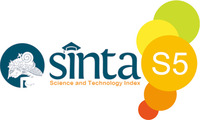The meaning of turtle symbols in the lyrics of the song Geobugi by Davichi
Abstract
Song lyrics are literary works that comprise linguistic symbols that possess meaning. This study examines the meaning of the turtle symbol used in the lyrics of a Korean song by Davichi named Geobugi. The purpose of this study is to describe the meaning of turtle in the lyrics of the song Geobugi by Davichi. This study uses a qualitative descriptive method to systematically describe the meaning of denotation, connotation, and myth using the theory of semiotics by Roland Barthes. The research results showed that the turtle in the lyrics of the song Geobugi symbolizes cautiousness, patience, self-reflection, hope, and self-defense. The turtle symbol depicted in the lyrics of this song conveys the message that humans can move slowly and patiently, do self-reflection, remain optimistic in difficult times, and have their defense mechanisms. The discovery of the meaning of myth provides a new perspective that something contradictory can be perceived as an option rather than a negative thing, which differs from the general perception of the dynamic and fast-moving Korean society.
Keywords
Full Text:
PDFReferences
Al-Falah, A., Kuswardono, S., & Irawati, R. P. (2021). Semiotika dalam lirik lagu ‘Al Barq Al Yamani’oleh Nissa Sabyan dan Adam Ali (Semiotics in the lyrics of 'Al Barq Al Yamani' by Nissa Sabyan and Adam Ali). Lisanul Arab: Journal of Arabic Learning and Teaching, 10(2), 59-73. https://doi.org/10.15294/la.v10i2.51936
Hasanah, N., & Hidayat, D. N. (2020). A semiotic analysis of political cartoons on the first 100 days of Anies Baswedan government. EduLite: Journal of English Education, Literature and Culture, 5(2), 322-333. http://doi.org/10.30659/e.5.2.322-333
Hwang, H. R. (2020). A research on the turtle’s symbolic ambivalence and its role as a spiritual guide for individuation entrance. Journal of Symbols & Sandplay Therapy, 11(1), 99-145. https://doi.org/10.12964/jsst.20003
Jung, B. (2021). Sandplay therapy performed by telepsychotherapy: Going beyond the limits of face-to-face psychotherapy in the covid-19 pandemic. Journal of Symbols & Sandplay Therapy, 12(1), 153-173. https://doi.org/10.12964/jsst.21004
Jung, W. H. (2019). 한류의 전개와 글로벌 수용의 변화 (The expansion of hallyu and changes in global reception. 지식의 지평(Horizon of Knowledge), (27), 39-52.
Kim, S. (2011). Interpreting South Korean competitiveness: From domestic rivalry to global competitiveness. Korea Observer, 42(4), 621.
Lee, P. Y. (2018). 거북놀이의 성격과 의의 (The character and significance of turtle play). 역사민속학 (Journal of Historical Folklife), (55), 191-223. http://doi.org/10.22792/jkhf.2018..55.007
Matthews, J. (2019). Sonamu–the cultural significance of the korean red pine. International Dendrology Society Yearbook, 72-79.
Mishchenko, T., & Pochtarev, N. (2021). The Bestiary’s code of Chinese culture through the images of the dragon, tiger and turtle. Confucius Institute in Sofia, 2021, 396. https://doi.org/10.2139/ssrn.3867381
Nafus, M. G., Germano, J. M., Perry, J. A., Todd, B. D., Walsh, A., &
Swaisgood, R. R. (2015). Hiding in plain sight: a study on camouflage and habitat selection in a slow-moving desert herbivore. Behavioral Ecology. 26. https://doi.org/10.1093/beheco/arv096
Nokelainen, O., Brito, J. C., Scott‐Samuel, N. E., Valkonen, J. K., & Boratyński, Z. (2020). Camouflage accuracy in Sahara–Sahel desert rodents. Journal of Animal Ecology, 89(7), 1658-1669. https://doi.org/10.1111/1365-2656.13225
Purwanto, A. (2021). Emotional ouotient analysis. PSYCHOLOGY AND EDUCATION, 58(3), 2280-2285.
Roh, N. S. (2018). 거북이의 상징적 의미 (The symbolism of turtles). 모래놀이상담연구 (Journal of Sandplay Counseling), 14(2), 1-16.
Rumambi, T. M. (2020). The symbolism of hope in the lyrics of a new day has come and i’m alive in Celine Dion’s album a new day has come. Journal of English Language and Literature Teaching, 5(2), 86-96. https://doi.org/10.53682/jellt.v5i2.6878
Siregar, I. (2022). Semiotic touch in interpreting poetry. Britain International of Linguistics Arts and Education (BIoLAE) Journal, 4(1), 19-27. https://doi.org/10.33258/biolae.v4i1.618
Yu, M. N. (2016). 민화 속의 거북 도상과 상징 (Turtle icons and symbols in folktales). 한국민화 (Journal Korean Folklore), (7), 132-161.
DOI: https://doi.org/10.17509/jokal.v2i2.49883
Refbacks
- There are currently no refbacks.
Copyright (c) 2022 Journal of Korean Applied Linguistics

This work is licensed under a Creative Commons Attribution-ShareAlike 4.0 International License.

Journal of Korean Applied Linguistics published by Universitas Pendidikan Indonesia is licensed under a Creative Commons Attribution-ShareAlike 4.0 International License.





